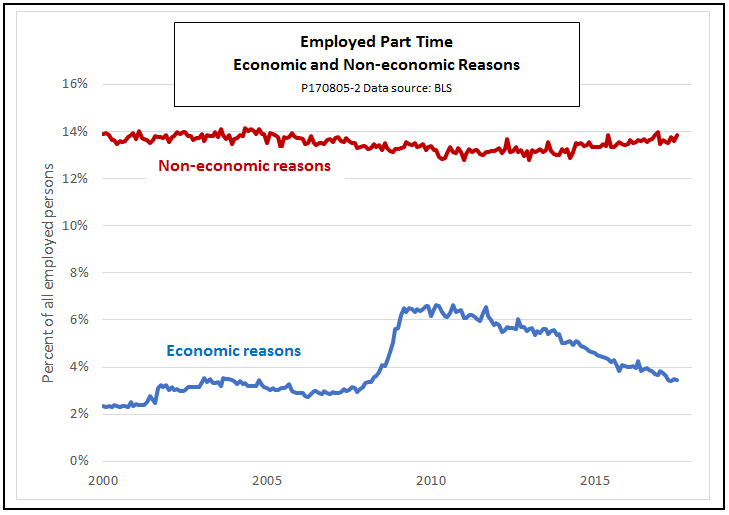Trends In Part-Time Work Reinforce View Of A Stronger Labor Market
The July employment situation summary from the Bureau of Labor Statistics showed continued improvement in the US labor market. Headlines were dominated by the news of a healthy 209,000 increase in total payroll employment and a return of the unemployment rate to 4.3 percent, the low for the recovery. However, other numbers, not always watched as closely, also show a recovery that is not in all ways complete.
Data on part-time employment are an example. The BLS counts anyone who works fewer than 35 hours per week as a part-time worker. It divides those into people who work part time "for economic" and "noneconomic" reasons. The "economic" category, often called "involuntary" part-time workers, are those who work short hours for a reason such as unfavorable business conditions, inability to find full-time work, or seasonal declines in demand. "Non-economic" or "voluntary" part-timers are those who work short hours for reasons such as childcare problems, family or personal obligations, school or training, retirement, or Social Security limits on earnings. The BLS data refer to part-time workers, not part-time jobs. A person with two part-time jobs that total 35 hours a week or more counts as a full-time worker.
As the following chart shows, part-time work has a distinct cyclical component. In 2006, the percentage of employed workers who were working part time hit a low of 16.2 percent, a number that rose to 20 percent by May 2009. The latest reading was 17.3 percent, just two-thirds of the way back to its prerecession low.

Not all part-time employment is alike. It turns out that most part-time employment falls into the voluntary category. As the next chart shows, in good times, about four-fifths of part-time workers choose such work for non-economic reasons. Even in the depths of the recession, two-thirds of part-time workers were voluntary.

All of the cyclical component—more than all, in fact—comes from the involuntary category. From its prerecession low to its cyclical peak, involuntary unemployment rose from 2.7 percent of all workers to 6.5 percent. In contrast, the voluntary part-time category falls slightly during recessions and rises during recoveries.
BLS data do not reveal exactly why voluntary part-time work moves in the opposite direction from the involuntary time type. Very likely, some part-time jobs that people hold voluntarily disappear entirely during recessions. At the same time, other workers, previously content with part-time work, may prevail on their employers to give them full-time hours, perhaps because another family member has lost a job.
Some people have pointed to the Affordable Care Act as a possible source of increased part-time work. That seems superficially plausible, since the ACA’s employer mandate applies only to employees who work 30 hours a week or more. However, economists at think tanks ranging from the conservative American Enterprise Institute to the more liberal Brookings Institution have failed to find convincing statistical evidence linking the ACA to the rise in part-time work.
Other research suggests that broader changes in the job market are at work. For example, one such study points out that the percentage of workers in non-traditional jobs, ranging from Uber to temporary help agencies, has increased by half over the last ten years. Whether that represents a weakening of the economy or a welcome shift to greater flexibility in employment options is not yet clear.



